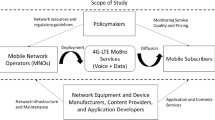Abstract
The importance of analyzing different business models and technologies in the mobile industry has become more crucial for the investment policy of the telecom operators. This paper aims to cover some of the most interesting business alternatives in providing the new 3G and beyond services including cases where the operator already has an existing second-generation cellular network and perhaps even a license for the 3G UMTS network, and cases where the operator does not have any existing network. Three cases for incumbents and new entrants are foreseen, leaving alternatives for new competing 3G technology deployment or acting as a mobile virtual network operator (MVNO) without owning any radio infrastructure. A techno-economic approach has been used to identify business opportunities and quantify the potential profitability of different kind of business players. The scenarios have been analyzed in the Western European context by different country groups that are not exactly representative of any defined country, but rather share typical demographic characteristics.
Similar content being viewed by others
References
Monath, T., (2003). Economics of fixed broadband access network strategies. IEEE Communications Magazine, 41, 132–139.
Katsianis, D., (2001). The financial perspective of the mobile networks in Europe. IEEE Personal Communications, 8, 58–64.
Ims, L. (1998). Broadband access networks introduction strategies and techno-economic evaluation. London: Chapman & Hall.
ECOSYS project web site: http://optcomm.di.uoa.gr/ecosys/deliverableslist.html.
Varoutas, D., (2003). Business opportunities through UMTS-WLAN networks. Annals of Telecommunications, 58, 553–575.
Harno, J. (2002). 3G business case successfulness within the constraints set by competition, regulation and alternative technologies. The Journal of the Communications Network, 1(2), 159–165.
Harno, J. (2005). With or without UMTS license—can network deployment with alternative technologies compete with UMTS in Europe? The Journal of the Communications Network, 4(3), 147–152.
Olsen, B. T., et al. (2006). Technoeconomic evaluation of the major telecommunication investment options for European players. In IEEE network, July/August 2006.
WiMAX Forum, website: http://www.wimaxforum.org/.
Global mobile Suppliers Association, GSA website: http://www.gsacom.com/.
Olsen, B. T., et al. (1996). Technoeconomic evaluation of narrowband and broadband access network alternatives and evolution scenario assessment. IEEE Journal on Selected Areas in Communications, 14(8).
Johansson, K. (2005). Cost efficient provisioning of wireless access. Licentiate thesis, Royal Institute of Technology.
Johansson, K., Zander, J., & Furuskar, A. (2007). Cost efficient deployment of heterogeneous wireless access networks. In Proc. IEEE vehicular technology conference VTC2007.
Pohjola, O.-P., & Kilkki, K. (2008). Value-based methodology to analyse communication services. In 5th conference on telecommunications techno-economics (CTTE2006). Athens, Greece, June 2006. Available at http:/holistic.nokia.com.
Smura, T., Kiiski, A., & Hämmäinen, H. (2006). Techno-economic analysis of mobile virtual network operators: strategies, investments, and revenues. In 5th conference on telecommunications techno-economics (CTTE2006), Athens, 8–9 June 2006.
Katsianis, D., et al. 3G mobile virtual network operators (MVNOs): business strategies, regulation and policy issues. In S. Park (Ed.), Strategies and policies in digital convergence. Idea Group Publishing.
Saunalahti Group Oyj (2004). Capital Markets Day presentation 30.11.2004. Available at http://www.saunalahtigroup.fi/.
Telenor. (2004). Partner contracts. http://telenormobil.no/bedrift/partnere/partneravtaler.do.
Samra, S. (2004). Worldwide success of CDMA2000: benefits to operators in 450 MHz. In CDMA450 evolution seminar. June 2004, Warsaw, Poland.
Albright, P. (2005). Revision of the vision. In Evolution. 01 November 2005. Available at http://www.telecoms.com/.
CDMA Development Group (CDG). (2005). Website. Available at http://www.cdg.org.
Author information
Authors and Affiliations
Corresponding author
Rights and permissions
About this article
Cite this article
Harno, J., Katsianis, D., Smura, T. et al. Alternatives for mobile operators in the competitive 3G and beyond business. Telecommun Syst 41, 77–95 (2009). https://doi.org/10.1007/s11235-009-9150-4
Published:
Issue Date:
DOI: https://doi.org/10.1007/s11235-009-9150-4




